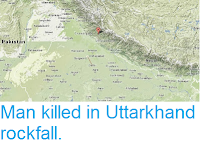At least nine people have died in flash floods that have hit the Indian State of Uttarakhand this week. In Pauri District two people, identified as Lakshya and Jyoti Arora, died when their house collapsed in Refugee Colony, trapping them beneath floodwaters, while two more people, Shanti Devi and Ajay Kumar, died in a similar incident in Manpur, and a sixteen-year-old girl, Muskan Bano, died in another house collapse at Lansdowne. In Pithoragarh District two bikers were drowned when they were knocked into the River Mahakali by floating debris, while in Tehri Garhwal District, a student drowned in the Tehri Dam Lake, and a child is reported to have drowned in a rivulet in Bagheswar District. A further two people are reported to have died in a landslide that hit the Nainital- Almora Highway at Khairna in Nainital District. Landslides are a common problem after severe weather events, as excess
pore water pressure can overcome cohesion in soil and sediments,
allowing them to flow like liquids. Approximately 90% of all landslides
are caused by heavy rainfall.
The aftermath of a landslide that killed two people at Khairna in Nainital District, Uttarakhand, this week. Skymetweather.
The incident is reported to have happened after four days of continuous rain in the area, associated with the Indian Summer Monsoon, with some districts reporting rainfall in excess of 120 mm falling within 24 hours. Monsoons
are tropical sea breezes triggered by heating of the land during the
warmer part of the year (summer). Both the land and sea are warmed by
the Sun, but the land has a lower ability to absorb heat, radiating it
back so that the air above landmasses becomes significantly warmer than
that over the sea, causing the air above the land to rise and drawing in
water from over the sea; since this has also been warmed it carries a
high evaporated water content, and brings with it heavy rainfall. In the
tropical dry season the situation is reversed, as the air over the land
cools more rapidly with the seasons, leading to warmer air over the
sea, and thus breezes moving from the shore to the sea (where air is
rising more rapidly) and a drying of the climate. This situation is
particularly intense in South Asia, due to the presence of the
Himalayas. High mountain ranges tend to force winds hitting them
upwards, which amplifies the South Asian Summer Monsoon, with higher
winds leading to more upward air movement, thus drawing in further air
from the sea.
Diagrammatic representation of wind and rainfall patterns in a tropical monsoon climate. Geosciences/University of Arizona.
See also...
Follow Sciency Thoughts on Facebook.








